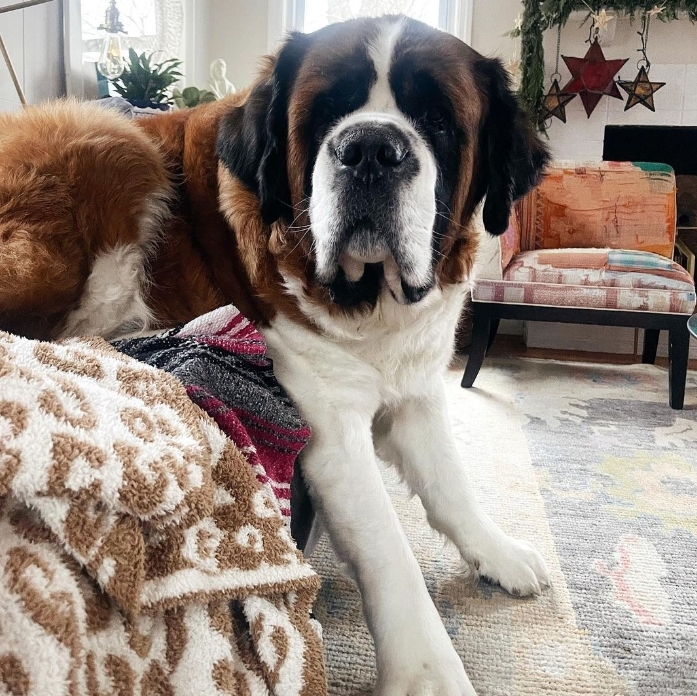Saint Bernard Dog
Table of Contents
Ever since I first laid eyes on a Saint Bernard, I've been captivated by their imposing yet gentle presence. Their legendary tales of snowy Alpine rescue always filled me with admiration and wonder. It's not just their heroics that have won me over, though.
Their loving and affectionate demeanor makes them impossible not to adore. For anyone like me who's had the privilege of knowing one, these gentle giants don’t just leave pawprints in the snow – they leave them on our hearts too.
History of the Saint Bernard Dog
The Saint Bernard dog, affectionately known to many as the gentle giant of the canine world, has a storied past that intertwines with the history of the European Alps. Originally referred to as the “Alpine Mastiffs,” these dogs have their ancient origins in the Swiss Alps. Their lineage is believed to be a mix of indigenous dogs that once lived in the Alps, and large Mastiff-type dogs brought to Switzerland by the ancient Romans during their campaigns.
The name “Saint Bernard” is inextricably linked to the Saint Bernard Pass, a perilous, snow-covered mountainous route approximately 8,100 feet above sea level, which connects Italy and Switzerland. Monks established a hospice there around the 11th century, aiming to aid and shelter travelers who braved this treacherous passage. By the 17th century, the monks had recognized the incredible skills of these Alpine Mastiffs in snow rescue operations.
Possessing an exceptional sense of direction and an uncanny ability to predict avalanches, the Saint Bernards became indispensable companions to the monks. Their powerful build allowed them to tread through deep snow, and their keen nose could detect the scent of lost travelers buried beneath the cold white layers. Equipped with a small barrel of brandy around their necks, which was believed to help warm and revive the rescued individuals, these dogs became iconic symbols of hope in the inhospitable terrain.
The Saint Bernard's fame skyrocketed in the 19th century when tales of their heroic rescues spread throughout Europe. Their reputation for saving lives led to a surge in their popularity. Throughout the years, and with the countless rescue missions they undertook, it is estimated that these noble canines have saved thousands of lives.

Physical Characteristics
Size
The Saint Bernard stands as one of the largest dog breeds, a veritable giant in the canine world. Adult males can reach a formidable weight range of 140-180 lbs, with their female counterparts being slightly more petite, weighing in at around 120-140 lbs. However, don't let their imposing stature deceive you; these dogs are often referred to as “gentle giants” because of their sweet and docile nature.
Coat
The Saint Bernard's coat is an integral part of its alpine heritage. Designed to withstand the harsh climate of the snowy Swiss Alps, their dense fur can be of two types: smooth or rough. While the smooth coat lies flat and is close to the body, the rough coat is slightly longer and has a wavy texture. Common colorations for this breed comprise red & white or brindle patches combined with a white base. Regardless of the coat type, the Saint Bernard's fur acts as a protective barrier against the cold, but it also means they require consistent grooming to keep it healthy and free of mats.
Head and Face
Saint Bernards possess a broad and powerful head, which is a defining feature of the breed. Their expressive eyes are generally of a dark shade, exuding warmth and intelligence. A furrowed brow and a deep-set nose give them a distinct appearance. Their ears are medium-sized, set high, and gently fall close to their head.
Temperament
A true testament to their monastic origins, the Saint Bernard exudes calmness and patience. They are exceptionally loyal and affectionate, making them excellent family pets. Their protective instinct ensures they are always alert and watchful, especially when it comes to the safety of children.
Lifespan
Given the appropriate care, a well-bred Saint Bernard can have a lifespan of around 8-10 years. Like many larger breeds, they have certain health issues that potential owners should be aware of, such as hip dysplasia or certain heart conditions. Regular veterinary check-ups and a balanced diet can aid in ensuring a longer, healthier life.
Activity Level
Though not as energetic as some smaller breeds, Saint Bernards still enjoy regular walks and playtime. Due to their size, it's essential to ensure they don't overexert themselves, especially in hot climates. Their history of alpine rescue means they have good endurance, but owners should be mindful of their joints, especially during their growth phase.

Personality and Temperament Saint Bernard
Saint Bernards, often lovingly referred to as “gentle giants,” have a temperament that belies their imposing stature. Delving deeper into their personality reveals:
- Friendly: These dogs are not just amiable, but they exude a warmth that makes them excellent companions for families. Their innate patience and tender nature make them particularly great around children. They can be protective yet gentle with kids, often seeing themselves as their guardians. Additionally, with the right socialization, they usually get along harmoniously with other animals, both big and small.
- Loyal: The loyalty of a Saint Bernard is unparalleled. Once they form a bond with a family member, it's not just superficial affection; it's a deep-rooted connection. This dedication means that they will stand by your side, showing unwavering loyalty through thick and thin. To a Saint Bernard, their human family becomes their pack, which they cherish and protect.
- Calm: One might expect a dog of such considerable size to be boisterous, but Saint Bernards are the epitome of serenity. They maintain a peaceful and relaxed demeanor most of the time, a characteristic likely honed from their historical roles as rescue dogs in the challenging Alpine environment. Their composed nature, however, doesn't mean they lack a playful side. When the mood strikes, especially in their younger years, they can be quite spirited and enjoy engaging in games or play sessions with family members.
- Intuitive: Beyond the aforementioned traits, it's worth noting the intuitive nature of Saint Bernards. Likely a result of their history in rescue operations, they seem to have an uncanny ability to sense the emotions of their human companions. Whether you're feeling down or jubilant, a Saint Bernard often seems attuned to these emotions, offering comfort or sharing in your joy.

Care and Grooming
Diet
Given the substantial size and stature of Saint Bernards, their dietary needs are distinct from smaller breeds. They require a balanced and nutritious diet that provides all essential nutrients. While they may not be as active as some breeds, their body mass demands a considerable amount of sustenance.
Owners should consult with veterinarians to tailor a feeding plan that meets their specific needs, considering factors like age, weight, and activity level. Offering them high-quality dog food with meat as the primary ingredient can be beneficial.
Moreover, because of their deep chests, they're prone to bloat, so it's essential to feed a saint bernard multiple smaller meals rather than a single large one and avoid vigorous activity right after eating.
Exercise
Although Saint Bernards aren't known for their boundless energy, they should not be mistaken for couch potatoes. Regular exercise is vital for their overall well-being.
Daily walks, adapted to their pace, can help in keeping them fit and preventing obesity, a common concern in larger breeds. Additionally, play sessions in a secure yard or open space allow them to stretch their legs and engage in interactive games, ensuring mental stimulation.
Remember, as puppies and during growth phases, it's crucial to moderate their exercise to prevent joint issues.
Grooming
The thick, dense coat of a Saint Bernard is both a boon and a bane. On one hand, it provided insulation during their historical alpine rescue missions.
On the other hand, it necessitates consistent grooming in domestic settings. To keep their fur healthy and free from matting, weekly brushings with a sturdy brush are essential. This not only helps in detangling but also in distributing natural oils across their coat, giving them a healthy sheen.
Occasional baths, depending on their activity level and the environment, can keep their fur clean and free from dirt or odors. Additionally, owners should pay attention to other grooming needs such as trimming their nails, cleaning their ears, and ensuring good dental hygiene.
Health Concerns
Saint Bernards, with their majestic size and gentle demeanor, unfortunately, come with a set of health concerns typical of many large breeds. To provide them with the best care possible, it's crucial to be aware of and understand these potential issues:
Hip Dysplasia
This is a hereditary condition where there's a malformation in the hip joint. Specifically, the ball and socket of the hip joint don't fit together perfectly, which can lead to arthritis over time. Dogs with hip dysplasia might limp, show signs of discomfort, or be reluctant to run, jump, or climb stairs. It's essential to keep an eye on their weight and avoid strenuous activities, especially when they're still puppies and their bones are developing. Early detection through X-rays can help in managing the condition.
Heart Issues
One of the most serious concerns for Saint Bernards is heart problems, especially dilated cardiomyopathy (DCM). DCM results in the heart muscle becoming thin and weak, which in turn can't pump blood efficiently. Signs to watch out for include fatigue, coughing, difficulty breathing, and sudden collapse. Regular check-ups with a veterinarian, especially a cardiologist, can help detect early signs and devise appropriate treatment or management plans.
Entropion
This is an uncomfortable condition where the eyelids, usually the lower ones, roll inward. This causes the eyelashes to rub against the cornea (the front part of the eye), leading to irritation, redness, and even potential vision damage if not treated. It's believed to have a hereditary component, and early surgical intervention can help correct the problem.
Bloat or Gastric Torsion
This life-threatening condition is prevalent in deep-chested breeds like the Saint Bernard. Bloat occurs when the stomach fills with gas and twists on itself. Rapid swelling of the abdomen, restlessness, and unsuccessful attempts to vomit are signs of this emergency. Immediate veterinary intervention is required.
Elbow Dysplasia
Similar to hip dysplasia but affecting the elbow joint, this condition can result in lameness and discomfort. Keeping a watchful eye on the dog's gait and seeking veterinary advice if limping occurs is essential.
Training Tips for Saint Bernards
Saint Bernards are not just gentle giants; they are also bright and inherently eager to please their owners. However, given their imposing size when fully grown, instilling good behavior early on is crucial to ensure they're manageable and sociable. Here are expanded training suggestions for Saint Bernards:
Start Early
It's never too soon to begin training a Saint Bernard. Puppies are impressionable and adaptable, making it an ideal time to teach them basic commands and manners. Furthermore, early training provides an opportunity to curb any unwanted behaviors before they become ingrained habits.
Socialization is Key
Alongside basic training, early socialization is paramount. Introducing your Saint Bernard puppy to different environments, people, other animals, and various stimuli can help them grow into well-adjusted, confident adults. This reduces the chances of them becoming anxious or aggressive in unfamiliar situations.
Be Consistent
Consistency is the backbone of effective training. Whether you're teaching basic commands or house rules, ensure everyone in the household uses the same cues and reinforces the same behaviors. This prevents confusion and ensures quicker internalization of training lessons.
Positive Reinforcement
Saint Bernards, with their eager-to-please nature, thrive on positive feedback. Using reward-based training techniques, such as treats, praises, or toys, can motivate them to learn and repeat desired behaviors. Remember, punishment or harsh corrections can be counterproductive and can potentially harm the bond between owner and dog.
Manage Their Strength
Due to their sheer size and strength, teaching a Saint Bernard to walk politely on a leash without pulling is essential. It's also beneficial to introduce them to weight-appropriate toys and games that channel their strength in a positive direction.
Patience and Persistence
While Saint Bernards are intelligent, every dog has its unique learning curve. Some commands or behaviors might take longer for your pup to grasp. Stay patient, break down lessons into manageable chunks, and celebrate small victories along the way.
Invest in Training Classes
Especially for first-time Saint Bernard owners, enrolling in a puppy training class can be invaluable. Not only does it provide structured learning for the puppy, but it also offers owners the tools and techniques to continue training at home effectively.
FAQs about Saint Bernard Dogs
Q: What is the temperament of Saint Bernard dogs?
A: Saint Bernards are renowned for their calm, gentle, and friendly disposition. Historically used as rescue dogs in the Swiss Alps, they are naturally compassionate and patient. They bond closely with their families, and their affectionate nature makes them particularly good companions for children. However, like all dogs, early socialization and training are important to ensure they grow up to be well-behaved adults.
Q: How much maintenance does a St. Bernard require?
A: St. Bernards can be considered high maintenance for a variety of reasons. Grooming-wise, their thick double coat means they need regular brushing to prevent matting and to reduce shedding. Their large stature requires a spacious living environment and also means they consume more food, which can escalate the cost of their diet.
Q: Can I count on a St. Bernard to protect my family?
A: St. Bernards are inherently friendly and gentle giants. While they're not typically aggressive, their loyalty to their family can make them protective when necessary. Their impressive size alone can serve as a deterrent to potential threats.
Q: How much do St. Bernard dogs shed, and how can I manage it?
A: St. Bernards are heavy shedders, especially during the shedding seasons in spring and fall. Their dense coat releases a substantial amount of hair, which can accumulate in your home. To manage this, regular grooming is essential. Daily brushing, especially during peak shedding times, can help remove loose hair and prevent matting.
Q: Are Saint Bernards suitable for families?
A: Yes, Saint Bernards are often considered excellent family dogs due to their gentle and affectionate nature. They tend to bond closely with their families and are especially good with children.
Q: How are Saint Bernards with young children?
A: Saint Bernards are generally patient and tolerant with young children. However, due to their large size, it's essential to supervise interactions to ensure that the dog doesn't accidentally knock over a small child in excitement or play.
Q: Do Saint Bernards get along with other pets in the household?
A: Typically, Saint Bernards are amiable and can get along well with other pets, especially if they are socialized from a young age. However, it's always a good idea to introduce new pets slowly and monitor their interactions.
Q: Are Saint Bernards protective of their family members?
A: While Saint Bernards are inherently friendly and gentle, they can be protective of their families. Their sheer size can deter potential threats, and they may display protective behaviors if they perceive a threat to their loved ones.
Conclusion
Having embarked on this journey to understand the majestic Saint Bernard, I've come to appreciate not just their historical significance, but the intricate tapestry of traits that make them so beloved. Their tales of alpine bravery, their heartfelt loyalty, and their gentle yet imposing presence have deepened my admiration for this breed.
The more I delved into their history, physicality, temperament, and care requirements, the more I realized that these “gentle giants” are not just dogs – they are an embodiment of devotion, courage, and love.
For anyone privileged enough to share their life with a Saint Bernard, they aren’t merely a pet; they are a testament to the incredible bond that humans and dogs have fostered over centuries. The pawprints they leave on snowy Alpine trails are impressive, but the ones they leave on our hearts are eternal.
Sources
https://www.ncbi.nlm.nih.gov/pmc/articles/PMC2562403/
https://vgl.ucdavis.edu/sites/g/files/dgvnsk8836/files/media/documents/StBernard20191116.pdf
Saint Bernard Dog Photos










